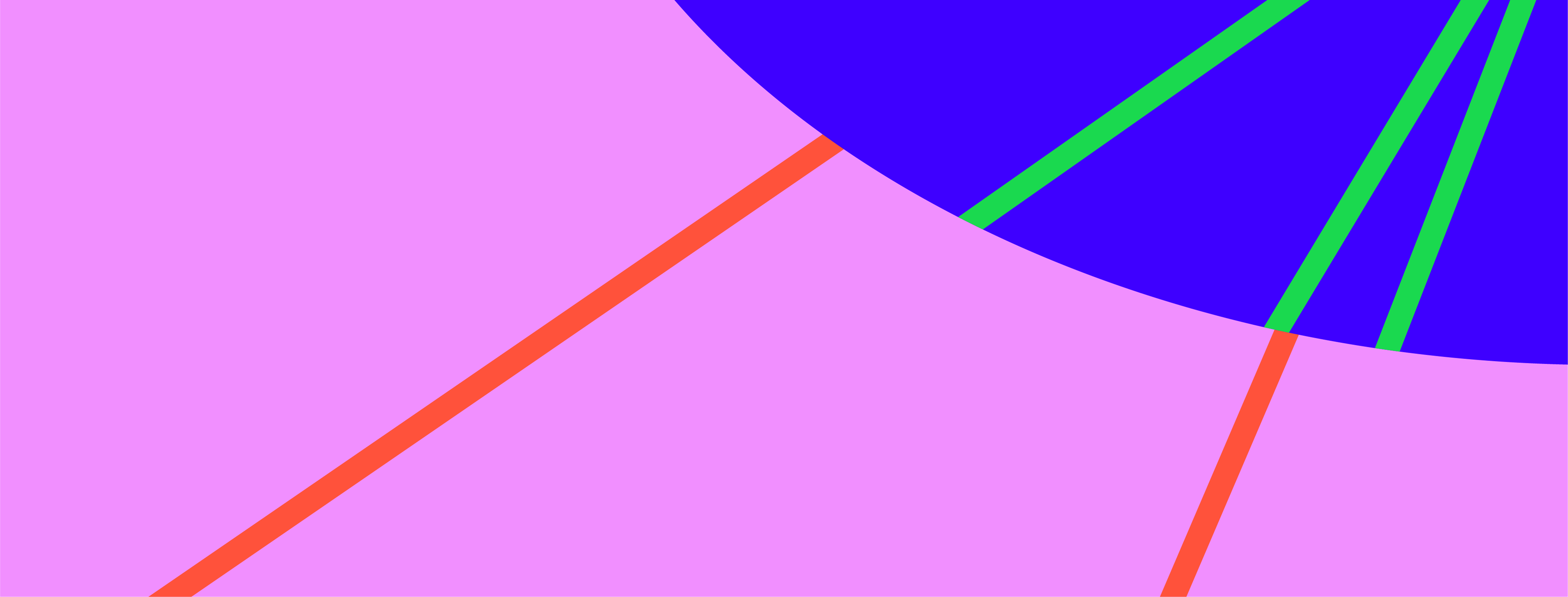W 2021 roku zostałam zaproszona do udziału w programie CuratorLab, dwusemestralnym kursie kształcenia podyplomowego dla kuratorów, organizowanym przez uniwersytet artystyczny Konstfack w Sztokholmie. Wraz z grupą młodych profesjonalistów uczestniczyłam w przygotowywaniu wystawy dyplomowej absolwentów szkoły. Miałam przy tym niepowtarzalną możliwość przeprowadzania obserwacji uczestniczącej całego procesu projektowania wystawy.
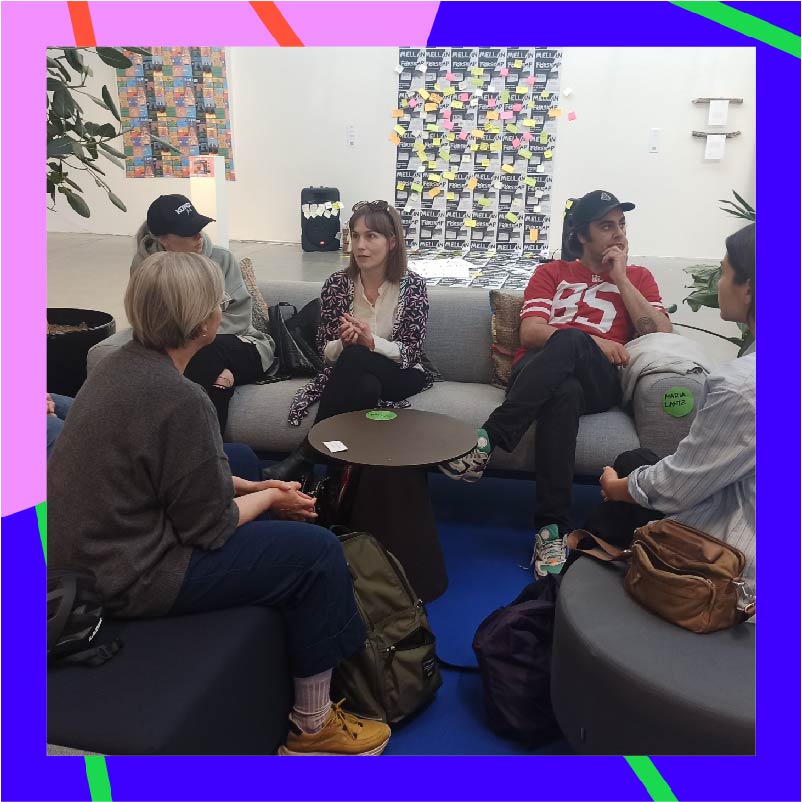
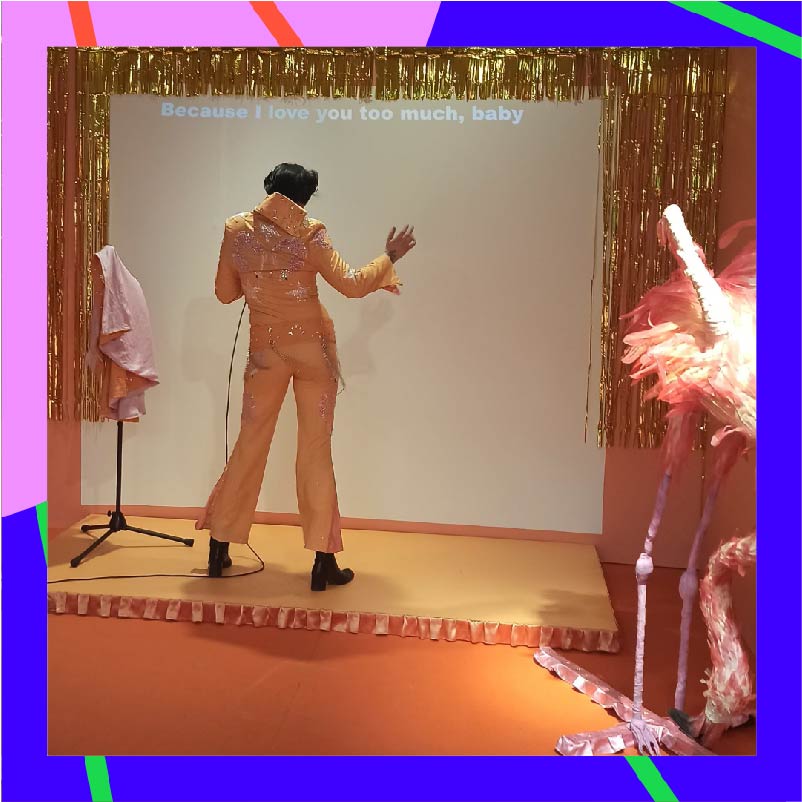
Dwanaście osób kuratorujących z całego świata, o różnym doświadczeniu edukacyjnym i zawodowym, które nie współpracowały ze sobą nigdy wcześniej, stanęło przed zadaniem wykuratorowania wystawy dyplomowej w Konstfack w 2022 roku.
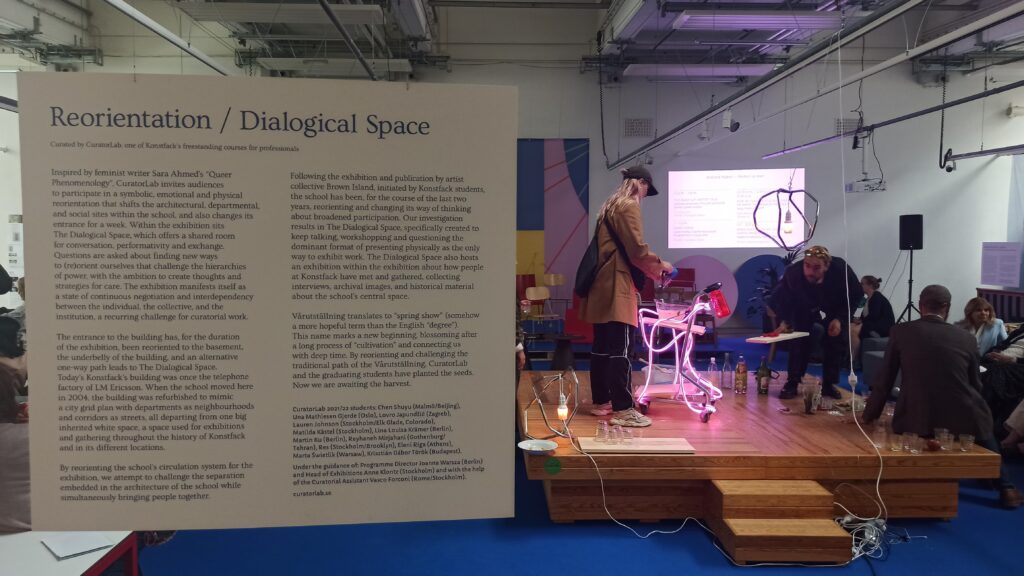
Zainspirowani fenomenologią queer feministycznej pisarki Sary Ahmed, zapraszamy publiczność do reorientacji architektonicznych, instytucjonalnych i społecznych założeń szkoły. Wejście do Konstfack zostaje na czas trwania wystawy przeniesione, a centralne pomieszczenie jest przeznaczone na „przestrzeń dialogu”: miejsce rozmów, spotkań i performansów. Wystawa manifestuje ciągłe negocjacje między jednostką, kolektywem i instytucją. Zamówiliśmy również teksty profesor historii i teorii sztuki Marty Edling na temat miejsca Konstfack w szwedzkim ekosystemie szkolnictwa, a także kuratorki Lisy Rosendahl na temat zagadnień związanych z wystawą dyplomową.
tekst wprowadzający w tłumaczeniu MŚ
REORIENTACJA: tekst kuratorski (ENG)

The master’s and teacher education students’ Vårutställning (which translates for a Spring show, a more hopeful term than Degree show) is curated by Konstfack’s CuratorLab. Inspired by feminist writer Sara Ahmed’s Queer Phenomenology, CuratorLab invites audiences to participate in a symbolic, emotional and physical reorientation that shifts the architectural, departmental, and social premises of the school, also changing its entrance for a week. Within the exhibition sits the Dialogical Space, offering a shared room for conversation, performativity and exchange. Questions about finding new ways to (re)orient ourselves that challenge the hierarchies of power are asked with the ambition to create new thoughts and strategies for care. The exhibition manifests a continuous negotiation and interdependency between the individual, the collective, and the institution, a recurring challenge of the curatorial work.
The entrance to the building has, for the duration of the exhibition, been reoriented to the basement, the underbelly of the building, and an alternative one-way path leads to the Dialogical Space. Through reshuffling given routes and expectations, our bodies are liberated to move and think differently. Can we find new ways to (re)orient ourselves to challenge the hierarchies of power – be that economic, social, or geopolitical? Can we unfold viable solutions to the state of crisis and wars that surrounds us? How do we position and navigate our bodies in a world that is falling apart? What seeds can we plant in the cracks for the eventual rebirth? This one-way route is arranged both for highlighting individual students’ work, but also to formulate a mode of exchange with one another, with one department to the other, with overlapping topics.
Today’s Konstfack’s building was once the telephone factory of LM Ericsson. When the school moved here in 2004, the building was refurbished to mimic a grid plan city with departments as neighborhoods andcorridors as streets, all departing from one big inherited white space, a space used for exhibitions and gathering throughout the history of Konstfack and its different locations. By reorienting the school’s circulation system for the Vårutställning, we attempt to challenge the separation embedded in the architecture of the school while bringing people together.
Following the exhibition and publication by artists collective Brown Island, initiated by Konstfack students, the school has been, for the course of the last two years, necessarily rethinking, decolonising and reorienting itself. Tor Lindstrand, Senior Lecturer in Spatial Design presented us with the question: ‘How do we continue the discussion about the school and its larger context when we are exhausted’? Our investigation results in a Dialogical Space specifically created to keep talking, workshopping, and questioning the dominant format of presenting physically as the only way to exhibit work. The Dialogical Space also hosts an exhibition within the exhibition, gathering interviews, archival images, and materials of the history of the school and its central space as a contextual activity.
Change, as the Vårutställning itself, is fluid. One week of reorientation will not shake a system to its core, nor tear down embedded hierarchies. However, it may plant a seed that, with time and cultivation, can grow to become a strong and proactive vehicle for change. To go beyond this moment, CuratorLab has also commissioned a collective portrait, ‘a time capsule’ of all MA graduating students by artist Annika Eriksson. The film is a central element of the Dialogical Space, where it is screened continuously, and additionally gifted to each student as a collective memory of their time at Konstfack.
Eriksson’s work, as well the whole exhibition, manifests a continuous negotiation between the individual, the collective, and the institution, a recurring challenge of the curatorial work of this year’s Vårutställning. After two years of their own separate practices, the graduating students now come together for one week. This grants a unique opportunity for audiences to see what is in the air, the span of interests and minds that embody the old telephone factory at Telefonplan, and marks both the end of the graduates’ time at Konstfack and the beginning of their post-graduate careers.
Vårutställning translates as spring show (somehow a more hopeful term than the English ‘degree’). This name marks both a new beginning, blossoming after a long process of ‘cultivation’ and connecting us with deep time. By reorienting and challenging the traditional path of the Vårutställning, CuratorLab and the graduating students have planted the seeds, now we are awaiting the harvest.
Przestrzeń dialogu
Jednym z głównych założeń kuratorskich było stworzenie w centralnym punkcie wystawy Przestrzeni Dialogu (Dialogical Space), która miała być miejscem spotkania, odpoczynku, zabawy, wymiany myśli. Głównym pomysłem aranżacyjnym było ułożenie na surowej, betonowej wylewce dużego dywanu wyznaczającego strefę spotkań i wykorzystanie umeblowania z różnych części szkoły, które przypominałoby o tym, że ta przestrzeń należy do wszystkich wydziałów.
„Dialogical space” (Przestrzeń Dialogu) to zaproszenie do współdzielenia doświadczenia spotkania w jednej przestrzeni artystów wszystkich wydziałów z publicznością i ze sobą nawzajem w programie wspólnych działań (warsztaty, wykłady, prezentacje, performansy), których program publikowany był na stronie wystawy.
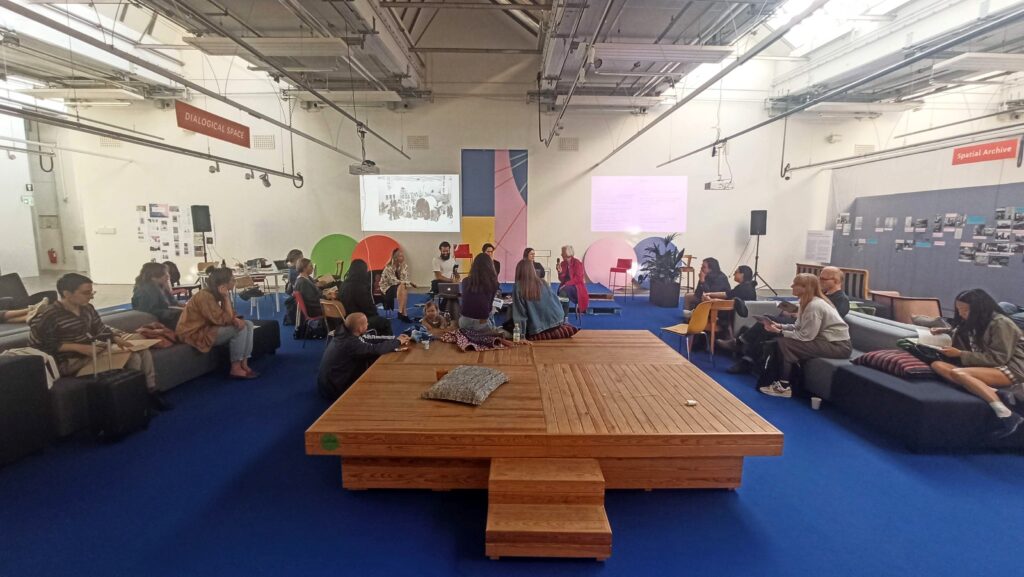
Behind Blue Curtain. Wystawa wewnątrz wystawy o przestrzeniach i uczuciach.
Wspólnie z członkami i członkiniami CuratorLab stworzyliśmy także „archiwum przestrzeni” (Spacial Archive) przedstawione w formie mini-ekspozycji „Behind Blue Curtain” wewnątrz wystawy głównej. Jej zadaniem było odniesienie się do historycznych przemian w rozumieniu zadań i roli społecznej uniwersytetu Konstfack oraz zajmowanych przezeń obiektów architektonicznych (ze szczególnym uwzględnieniem przestrzeni wystawienniczej nazywanej Vita Havet — Białe Morze, będącej od początku integralną częścią szkoły).
W ciągłym przepływie przed i po, studiowaniu, nauczaniu lub kończeniu studiów jest jedna rzecz wspólna dla studentów i pracowników Konstfack: szkoła i jej dziedzictwo, jej historia i jej martwe punkty. Archiwum przestrzeni „Behind Blue Curatin” jest na to kontekstualną odpowiedzią, która energetyzuje teraźniejszość, problematyzując relacje między przestrzeniami, uczuciami i archiwami.
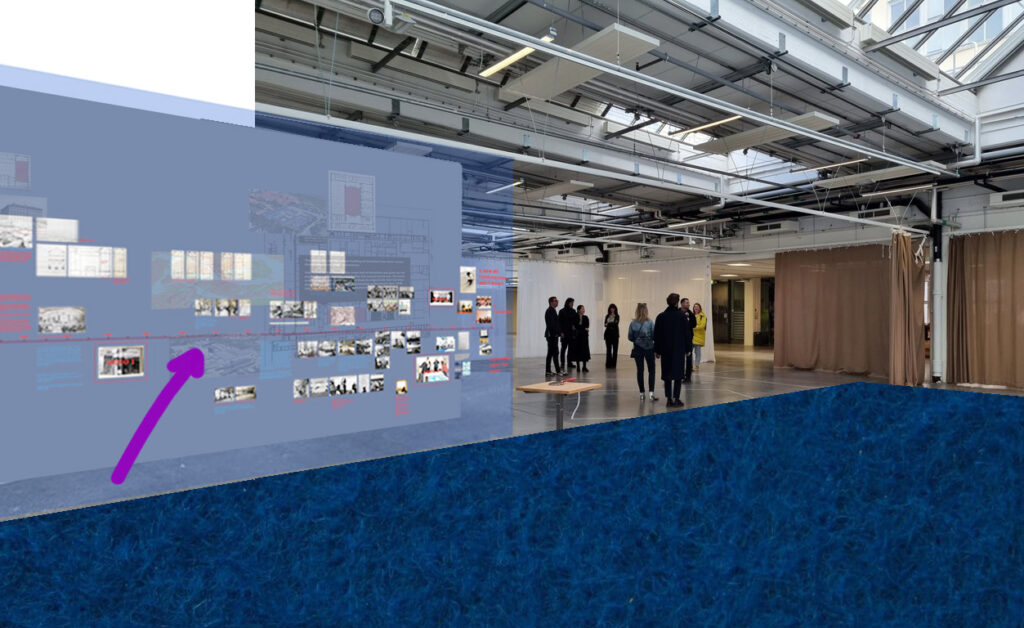
Zadanie badawcze
Obserwacje i dane zebrane przeze mnie pomiędzy październikiem 2021 a czerwcem 2022, stały się podstawą case study przedstawionego w mojej pracy doktorskiej, który stanowi przykład ogólnych tendencji we współczesnych działaniach kuratorskich i strategiach odbioru wystaw w okresie postpandemicznym.
Więcej na ten temat już wkrótce w kategorii projekt doktorski.
